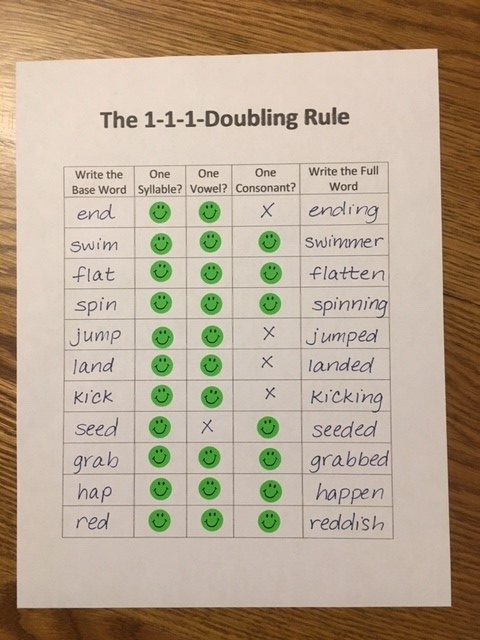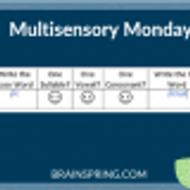1-1-1-v Doubling Rule: Meaning, Activity, Words, & More
Posted by Tammi Brandon on 31st Dec 2018
The 1-1-1-v Doubling Rule is difficult for many students, often requiring additional practice. If you’re looking for a quick and simple way to help students practice spelling words with and without this rule, print off the attached chart and grab some small stickers (a rubber stamp could be used in place of stickers).
What is the 1-1-1-v Doubling Rule?
The 1-1-1-v doubling rule is crucial for early literacy development because it helps young learners understand the patterns and rules of English spelling. This rule doubles the final consonant in a word when adding a suffix that begins with a vowel if the word follows a specific structure (one syllable, one vowel, one consonant). Thisaids in making spelling more predictable for students.
Mastering the 1-1-1-v doubling rule enhances a child's ability to decode and spell words correctly, paving a path for more advanced reading and writing skills. By grasping this rule early on, students can build confidence in their literacy abilities.
Differentiating Between Vowel Suffixes & Consonant Suffixes
The 1-1-1 doubling rule applies only when adding a suffix that begins with a vowel, such as -ing, -ed, or -er. This distinction is important for students to understand because suffixes beginning with consonants, such as -less or -ment, do not follow the same doubling rule. For example:
Vowel Suffixes:
- Hop → hopping: The final consonant is doubled because the base word is one syllable, has one vowel, and ends in one consonant.
- Big → bigger: The final consonant is doubled before adding -er.
Consonant Suffixes:
- Mad → Madness: No doubling occurs because the suffix begins with a consonant.
- Dim → Dimly: No doubling occurs because the suffix begins with a consonant.
Teaching this distinction helps students understand when the rule applies, preventing confusion and reinforcing accurate spelling. A simple way to practice is by having students sort suffixes into "vowel" and "consonant" categories and apply them to base words to see the effect.
Exceptions to the 1-1-1-v Doubling Rule
While the 1-1-1 rule is generally consistent, there are exceptions that students should be aware of. Some words, despite following the one-syllable, one-vowel, one-consonant structure, do not double their final consonant.
Key exception: Words ending in "x," "w," or "y" are never doubled:
- Fix → fixing: The "x" is not doubled.
- Snow → snowing: The "w" is not doubled.
- Play → playing: The "y" is not doubled.
These exceptions occur because these letters are structurally or phonetically incompatible with doubling. For example, "x" already represents two sounds (/k/ and /s/), making doubling unnecessary. Similarly, "w" and "y" function more as diphthongs and do not conform to the doubling rule.
1-1-1-v Doubling Rule Words
Hop → hopping
Run → running
Chat → chatting
Fit → fitting
Beg → begging
Stop → stopping
Rob → robbing
Slam → slamming
Plan → planning
Win → winning
1-1-1-v Doubling Rule Activity
Follow these steps for the activity shown below:
- Using words that contain a base word and a suffix (choose a combination of suffixes that begin with either a vowel or a consonant), dictate a word to the students.
- The student then writes only the base word on the chart.
- Providing that the word has onesyllable, the student places a sticker in the corresponding column on the chart.
- If the word has one vowel, the student adds another sticker. If the word has a single consonant after the vowel, the student adds the third sticker.
- Supposing that the word is not one syllable or contains more than one vowel or one consonant after the vowel, leave those columns blank or place an X in them.
Lastly, if there are three stickers next to the base word, the student should double the final consonant before adding a suffix that begins with a vowel. (Remember that X, W, and Y are never doubled.)
Multisensory Activity Example
Let’s look at the base word “fitted”. Dictate the word “fitted” to your student and have him or her write only the base word in the first column.

Now ask, “Is it a one syllable word?” It is, so add a sticker to the column labeled “One Syllable?”

Then ask, “Does it have only one vowel?” It does, so add a sticker to the “One Vowel?” column.

Next, ask, “Is there only one consonant after the vowel?” There is, so add a final sticker to the “One Consonant?” column.

Because there are three stickers, the T in “fit” must be doubled when adding a suffix that begins with a vowel.

Repeat the activity with additional words.

To print a blank copy of the sticker chart, click here:
111 Doubling Rule Sticker Chart
Written by Tammi Brandon, M.Ed., CDP
Tammi Brandon is a Master Instructor and Education Consultant with Brainspring Educator Academy.nul

